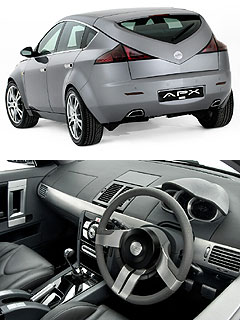First look: Lotus stuns with APX crossover
BY MARTON PETTENDY | 27th Feb 2006

The first example of a complete vehicle built on the sports car maker’s new Versatile Vehicle Architecture (VVC), APX offers the performance to match the most potent hyper-SUVs from BMW, Mercedes-Benz and Porsche.
The lightweight (1570kg) APX’s striking five-door wagon design and its 224kW supercharged V6 are a taste of things to come from Lotus, whose VVC platform will first spawn an all-new mid-engined "super sports car", likely to be labelled the Esprit V8, in 2008.
APX, meantime, is aimed at showcasing the Proton-owned manufacturer’s ability to develop niche vehicles in their entirety, including vehicle design and powertrain engineering.
A seven-seater with two "occasional" third-row seats, APX is manufactured predominantly from aluminium using advanced assembly techniques like adhesive bonding, self-piercing rivets and flow-drill screws, or joining techniques Lotus calls Riv-Bonding.
Lotus says these technologies have significantly reduced the number of mechanical fixings within the monocoque structure, thus reducing the level of tooling investment required.
The company says APX is not simply a concept but a feasible prototype close to production, and could be built in high niche volumes of up to 30,000 vehicles annually.
However, at the same time, Lotus Engineering warns APX is not a concept that indicates a strategic direction for Lotus Cars. Instead, it’s: "a brilliant demonstration of VVA and the skills of the team from Lotus Engineering into what is regarded as the future of niche vehicle manufacture."

Mounted longitudinally up front in the APX, it features an 88mm bore, 82.1mm stroke, 2.996-litre displacement and delivers a sports car-like power-to-weight ratio of 142kW/tonne, along with 0-100km/h acceleration in just 5.4 seconds and a 245km/h top speed.
Like the APX itself, the engine – which is claimed to return fuel consumption of just 8.7L/100km/h - is purported to be a feasible prototype close to production.
But, in an equally contradictory statement, Lotus says that "rather than indicate Lotus Cars’ strategic powertrain direction ... it is expected that the commercialisation of this engine will be of interest to the automotive clients of Lotus Engineering".
"The first production car from Lotus to use the Versatile Vehicle Architecture will be the new mid-engined super sportscar, which will go into production in 2008," said director of Lotus Engineering Simon Wood.
"Lotus Cars customers eagerly await this vehicle that will be a class-leading and phenomenally high performing car. However, we wanted to demonstrate the true versatility of the VVA technology, and what better way than to build a type of car that no one would expect from Lotus - a four-wheel drive crossover vehicle.
"I am delighted with this vehicle and we believe that this technology and strategy is what the motor industry must follow to be able to produce niche vehicles efficiently and quickly.
"There is already a great deal of interest in both APX and VVA technology from our client base and we will work hard to see how Lotus Engineering can help them with their strategic product solutions." While APX and Esprit will represent the first vehicles to be built on Lotus' new VVA architecture, the British-based, Malaysian-owned company will also showcase its all-new Europa S rear-drive GT coupe at Geneva, alongside APX.
Based on a stretched version of the Elise roadter/Exige coupe platform, the sub-1000kg Europa will be powered by a turbocharged 2.2-litre Ecotec four-cylinder engine shared with the Vauxhall VX220 (see separate story).
What's coming from Lotus:
Lotus Europa S coupe - 2007Lotus Esprit V8 - 2008
Lotus APX SUV - 2009